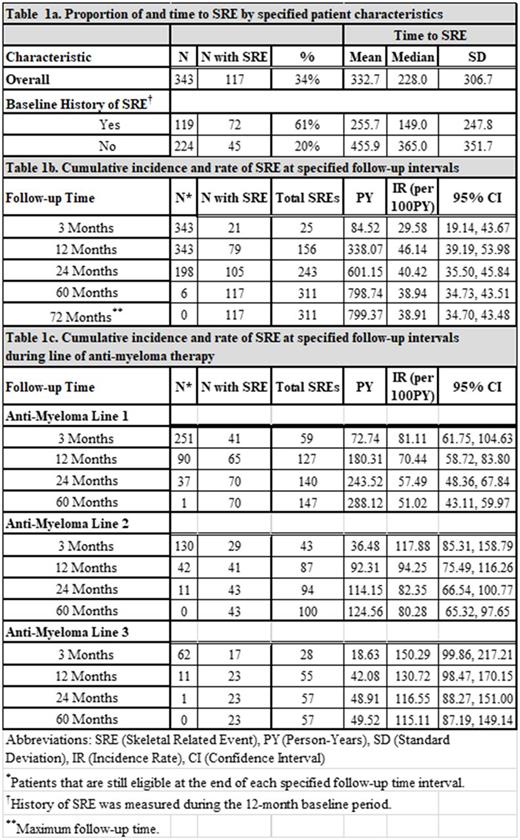Abstract
Introduction: SEER estimates that 30,280 new cases of multiple myeloma (MM) will be diagnosed in the US in 2017. Osteolytic disease is a hallmark feature of myeloma at diagnosis. Skeletal related events (SRE) including pathological fractures, spinal cord compressions, radiation and surgery to bone are frequent complications for myeloma patients. However, there have been few reports of the incidence of and risk of developing an SRE in the myeloma population, particularly relative to concomitant anti-myeloma therapy.
Methods: A database of oncology electronic health records (EHR) contained in Amgen's Oncology Services Comprehensive Electronic Records (OSCER) database, generated by Flatiron Health (New York, NY, April 30, 2016) were linked to administrative claims data from the Truven Marketscan database. Patients identified were individuals 18 years or older diagnosed with MM (ICD-9: 203.00; ICD-10: C90.00), had at least 1 clinic visit within 1 month of diagnosis, and at least 1 year of follow-up after MM diagnosis. The study period was from January 1, 2011 to December 31, 2016. The baseline period for co-morbidities was 12 months prior to multiple myeloma diagnosis date. Patient diagnosis, treatment dates and administrations were ascertained from the EHR. SREs were ascertained from diagnosis codes in insurance claims. Primary outcomes of interest were occurrence of and time to SRE. Multiple SRE that occurred within a 21-day span were considered as a single SRE and ordered based on the following hierarchy: 1.) spinal cord compression, 2.) pathological fracture, 3.) surgery to bone, then 4.) radiation to bone. SRE occurring within 60 days of MM diagnosis were considered as baseline SRE. Results are also stratified by line of anti-myeloma therapy.
Results: A total of 343 patients were included in this study. Approximately 55% of patients were age >65, 54% male, and 70% white race. About one-third of patients had an eGFR below 60 at MM diagnosis, 69% presented with anemia, and 35% had a baseline history of SRE (includes SREs recorded within two months after diagnosis). During a median follow-up of 25.7 months after diagnosis, 34% of patients (n=117) experienced an SRE and the median time to SRE was 228 days. Among patients that experienced a SRE, 68% occurred within the first year (n=79). Among patients with a baseline history of SRE (n=119), 61% experienced a SRE during follow-up at a median of 149 days compared to 20% of patients without SRE history (n=45) at a median of 365 days. The incidence rate of SRE for these patients with a baseline history was 103/100 person-years (PY) (n=58) versus 16/100PY compared to no baseline history (n=21) one year following MM diagnosis. The incidence rate of SRE in each of line therapy within three months of the initiation of each line increased with each subsequent line (line 1: 81/100PY, line 2: 118/100PY, line 3: 150/100PY).
Conclusions: Most patients experience their first SRE soon after MM diagnosis or at the beginning of each relapse. Patients with a baseline SRE had a higher risk of future SRE. Recently relapsed patients had a higher rate of SRE compared to patients who have been on therapy for an extended period, and the incidence rate was progressively higher among patients receiving later lines of therapy. Additionally, among patients experiencing SRE, multiple SRE can occur, highlighting the importance of continued surveillance and proper management of myeloma associated bone disease. The overall SRE rate was lower than expected likely due to selection bias or recording bias in the administrative claims database.
Bhatta: Amgen: Employment. Fonseca: Jansen: Consultancy; Merck: Consultancy; Mayo Clinic & Dr Fonseca: Patents & Royalties: Prognostication of myeloma via FISH, ~$2000/year; Bristol-Myers Squibb: Consultancy; Novartis: Consultancy; Celgene Corporation: Consultancy, Research Funding; Sanofi: Consultancy; Takeda: Consultancy; Adaptive Biotechnologies: Membership on an entity's Board of Directors or advisory committees; Bayer: Consultancy; Pharmacyclics: Consultancy; AMGEN: Consultancy. Hernandez: Amgen Inc.: Employment, Equity Ownership. Kim: Amgen, Inc.: Employment, Equity Ownership.
Author notes
Asterisk with author names denotes non-ASH members.


This feature is available to Subscribers Only
Sign In or Create an Account Close Modal